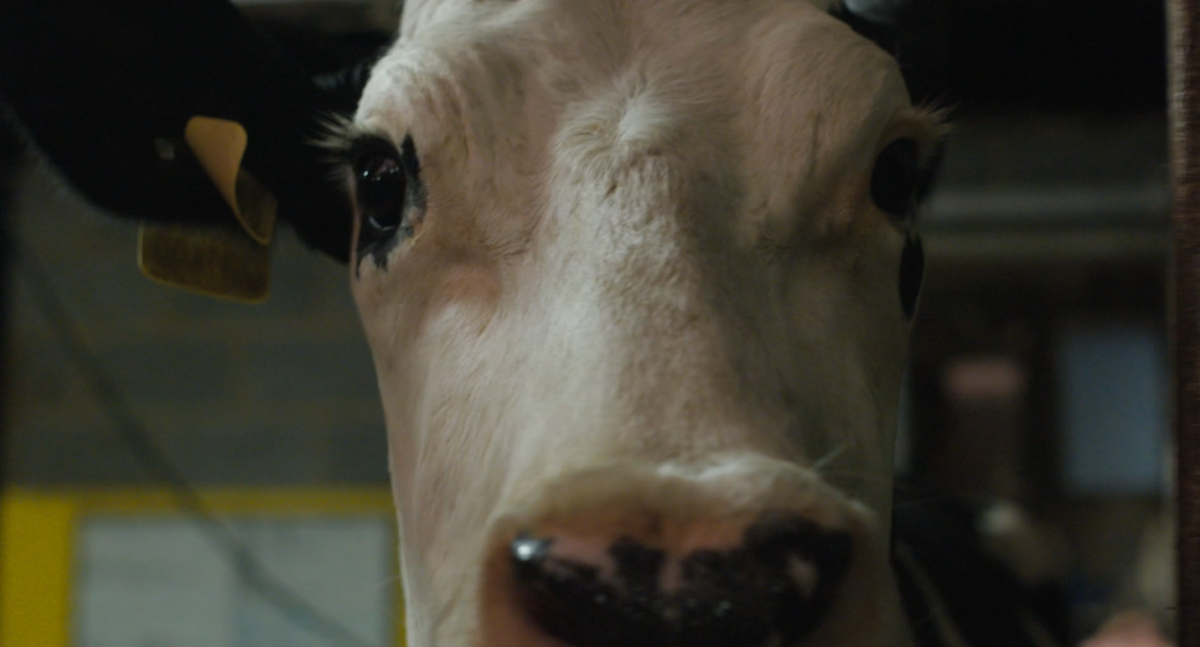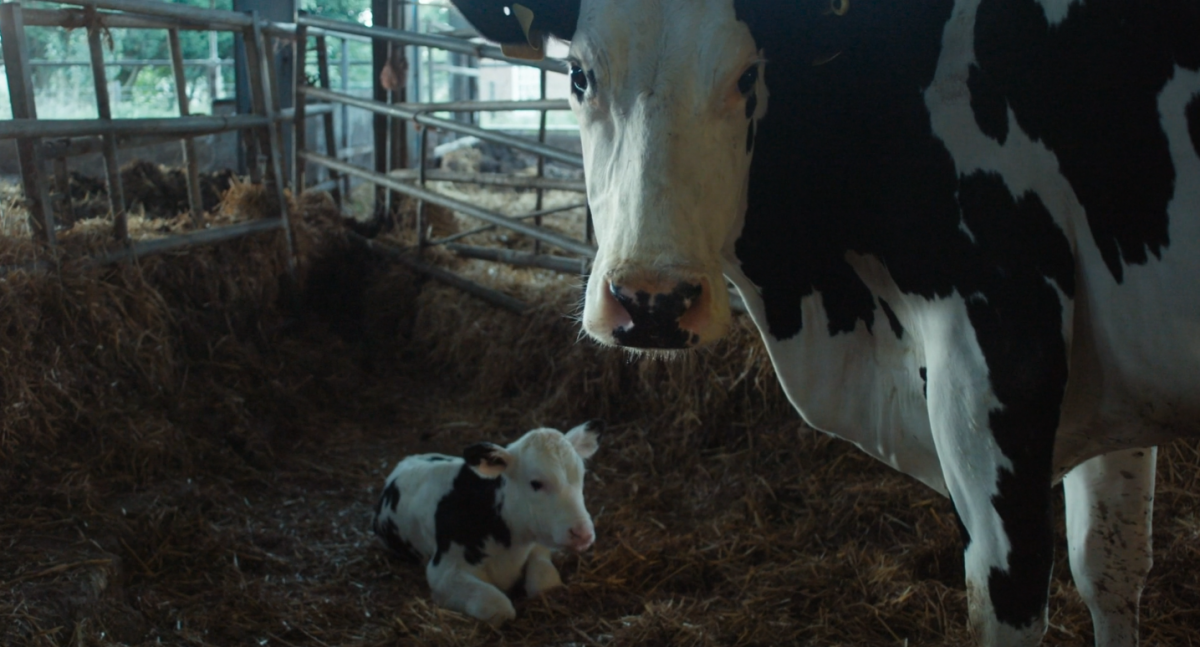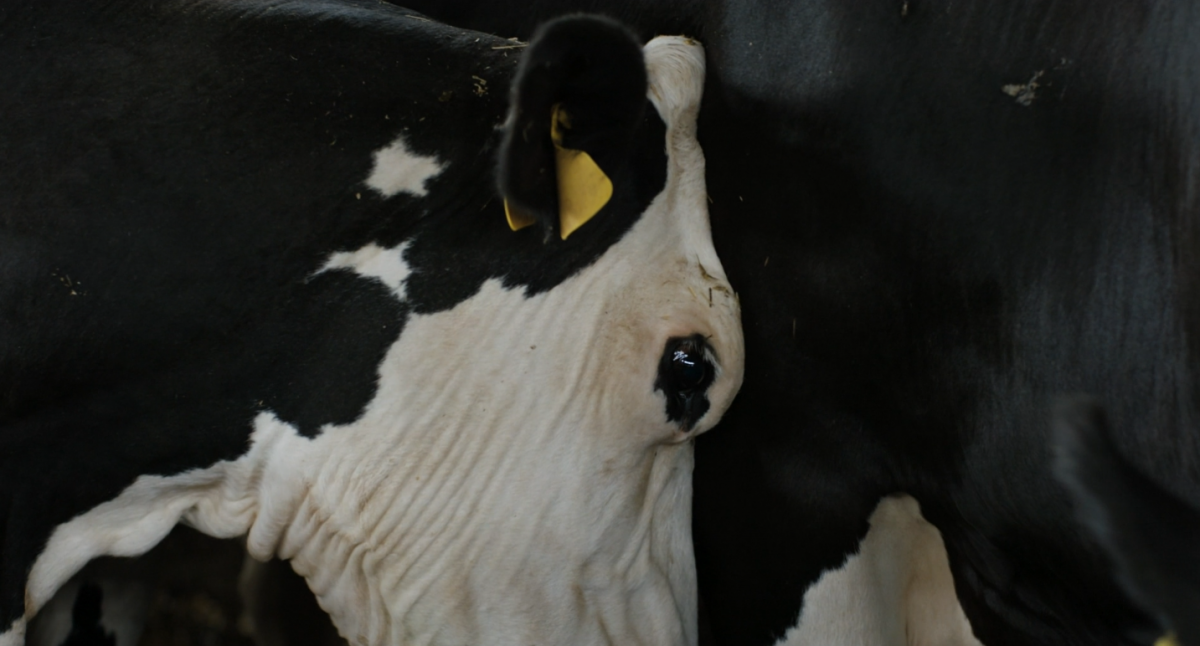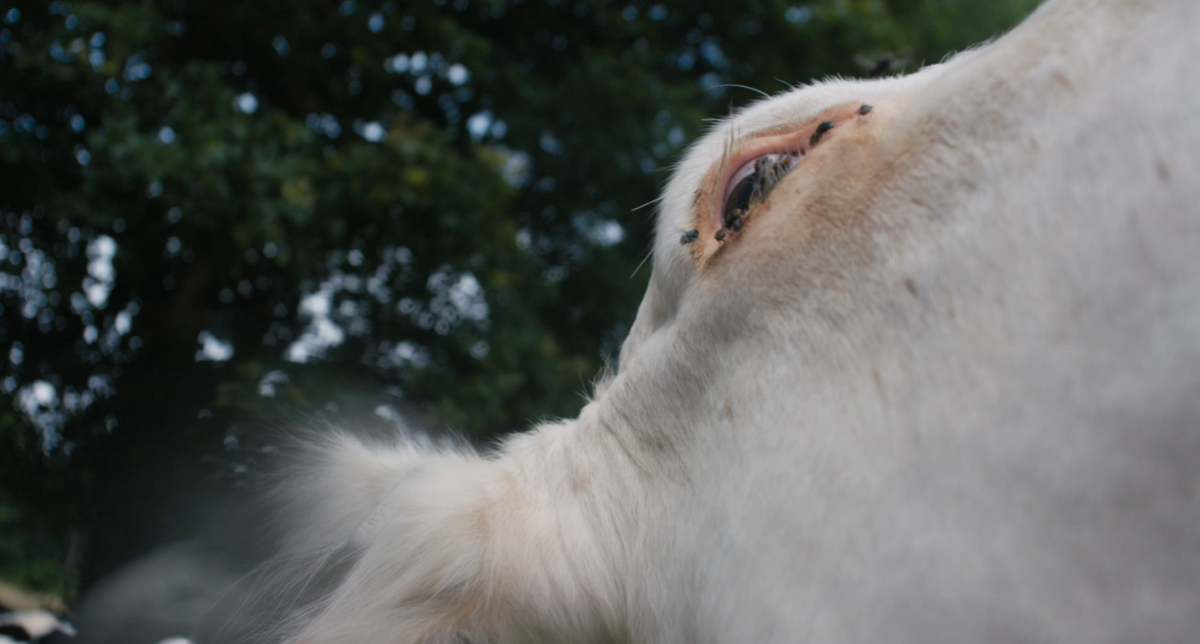Letters about Cows and Tears

Dear Leonardo,
When we left the theatre at the Viennale after seeing Cow by Andrea Arnold, I was brushing the tears away from my eyes. Is an insightful conversation possible when one is clouded by emotions? I do think this is possible, because what happened during this film might be of interest to us.
Just to give a short sketch of the facts: In a cinema full of delighted spectators, we were presented a film in which we follow the life of a dairy cow. The camera follows the cow’s routines in close-up as she gives birth to a calf and nourishes it for a moment before it is taken away and she is immediately led back to the milking machine. This cycle repeats itself until she is killed. I do not apologize for this harsh synopsis. I can give away the ending to our readers since there is no spoiler when we already know the end of story the moment the film starts. Millions of cows, characters similar to the one featured in Cow live and die in a similar way.
“There are worse things happening in the world”, you said.
During the Q&A, one spectator asked Arnold to clarify her political point of view. Why did she make this film? What was her intention? The woman seemed very eager to hear the response, since it seemed important to her that the feelings she had while watching the film be validated by the filmmaker reassuringly stating, yes, it is a political film, and, indeed, it is an invitation for consumers to take action and do something about this dreadful industry. I think it was a common feeling among the spectators; to be subjected to this immense tragedy, the confirmation of a moral and political statement would help to put at ease the suffering spectator; it was all for the good. We needed this lamentable experience to become better people.
It’s a rather complex question, which is posed mostly in relation to documentary films: What is the aim of the film? What was the intention of the filmmaker? In a documentary there is always something that escapes art. Andrea Arnold responded to the question that she was simply interested in seeing how milk, something we use every day, is produced. Curiosity is always a good reason for making a film. However, the objectivity of her answer contrasts with the method she chose to satiate her curiosity.
Many of Andrea Arnold’s films are tearjerkers. Interestingly, because it is a documentary, Cow is thus different from her other work. The “fabulated distance” of fiction is not present, while we are drawn into the real tragedy of livestock. The camera focuses on the eyes of the cow, whose name is Luma. Sometimes it’s the left one, sometimes the right one, but there is always this big black eye, seemingly filled with tears in every shot. During the screening, I asked myself constantly, “Why are we forced into this black pool of a suffering gaze?” In an interview, Andrea Arnold answered, “What I want is for you to have your response. I deliberately made it in a way that will give room for people to have all kinds of responses.” Somehow this answer seems cruel.
Leonardo, what is the aim of suffering in cinema, especially in documentary cinema? When I experience these strong emotions, I often feel lured and manipulated. Do you have words to describe the problematic relation between a big black crying eye and the big blue world, where there are always “worse things happening”?
I also cannot brush off the terrible feeling about how cows are objectified in modern food production. The cruelty imposed on them is institutional rather than physical. The cow is never beaten but gently and decidedly guided away from her calf and into the milking machine – the sole purpose of her life. All that makes the life of a mammal meaningful is “industrialized away” into the mechanic of production. In our contemporary food producing facilities, individual life is reduced to a cog in a wheel of productivity – very literally so in the case of dairy cows. They fulfill the purpose of their lives in the moments they are hooked to an enormous milking machine, which slowly revolves like a monstrous gear.
But there is another problem. I think what made me feel doubly sad – with twice the flow of these humiliating clichéd tears – is that I felt that Luma was being objectified in two ways: first, by the system of production/destruction, and second by Arnolds production of spectacle. Luma’s body is ultimately conquered by the production of milk and tears.
Leonardo, since your eyes remained dry, do you have a clearer vision of the way Arnold has used the life of Luma as the perfect raw material for a modern drama film?
Nina

Dear Nina,
Far from enabling any sort of retrospective clear view or particular insight, leaving the theater with dry eyes does not mean more than that the spectator in question has successfully protected himself against what could (or should) disturb him. The same goes for the remark about “worse things happening in the world” – it’s a coarse way of taking your own measure of how many images of the suffering you can stand and take home with you after the lights in the cinema come on.
However, it’s hardly possible not to be affected one way or another by the suffocating pain of the main “character” in the new film by Andrea Arnold. We watch Luma pretty much in continuous close-up. We see her massive body trembling, we hear her deep troubled breathing, we feel growing agitation and despair in the way she walks and looks at us. Indeed, in her own world, the worst is happening. At first, we simply feel sorry for her; then we are tormented and we cry or resist crying, depending on our own dispositions. In this case, tears only indicate our own particular limits, the point after which we collapse into powerlessness. They mark the moment when our empathy becomes our burden.
Until the appearance of this burden, our affair with the cow, as with the film, is still clear and straightforward: we were offered the object of compassion and we have readily accepted it. In the arts, it was – and still is – business as usual for centuries: provoking compassion for the real or fictional objects of suffering was a tool for the purification of emotions – catharsis – which would then produce a relief. This dramaturgy of catharsis is however instrumental: traditionally, it is destined to produce either moral elevation or lessons about emotional dangers. Its use was expanded in the Hollywood early studio system, mostly in melodramas, in order to exchange some tears – extorted from spectators precisely by a lingering close-up of the face or eyes of a misfortunate woman, child or animal – for a couple extra bucks.
Certainly, the intentions of Andrea Arnold, like that of many other “engaged” independent filmmakers, are far more noble although less generous. The burden of empathy she creates, or simply the shock she produces with her images, is not as easily dissolved as in lighthearted romantic or melodramatic films. Since her intention is noble – to engage the public in learning something about the hard reality behind our everyday life and to invite them to transform it – the spectator/cinephile is supposed to assume more suffering, to endure the pain of the character until the end and then bring it home with them. In a way, the strategy of many engaged independent filmmakers is a certain turn, a reversal from the harmless “purification of emotion” to the impossibility of getting over it, from innocent tears we soon forget to the induction into a trauma one should never forget without feeling guilty.
The problem of pedagogical stance in contemporary cinema is quite risky business in terms of effectivity. There is no guarantee whatsoever the spectator will receive the message the way the filmmaker conceived it, and there is even less guarantee there will be any measurable effects produced by these images. Cinema, as an art of moving images and as the dark room of a projection, is probably the last place one should look for the approbation of any truth, however obvious it might appear in the light of day. As a realm of a play of appearances, of indeterminate meaning of all shapes we see on the screen and that of ambivalences of every particular image, cinema will always be a space of freedom. This will be the case at least if the author of the images projected on the screen treats spectators with a minimum of generosity – as sensible and reasonable beings who can decide on their own about their duties and obligations for the world, as well as about the meaning and purpose of the images they are being presented with. My impression is that Andrea Arnold in her latest film lacks that basic generosity. Our gaze on Luma’s eyes is fixed, hypnotized, forced to identify with her. There is nowhere our gaze could lose itself in an insignificant detail. Our focus is strictly navigated. Our field of vision is constrained, and the point of the film is being shoved in our faces: “Look at the condition of the cow whose milk you drink. Shouldn’t you finally switch to one of those vegetable milks?” Of course, Arnold didn’t need a voiceover narration to tell us that – the transfer of guilt is operated most elegantly by the speechless gaze from eye to eye.
Naturally, it’s not easy to get rid of this transferred guilt afterwards, and one can certainly feel tricked for crying so many tears during a film like this, as you have felt. From that feeling, one can easily slip into resentment, into an anger of being fooled and trapped, and thereby further into misbelief or even cynicism. This is where this vicious circle of the pedagogy of cinematic cruelty ends: laughing while witnessing a character in pain on the screen. Being always far more innocent than laughing, we should never regret crying in the theater; it keeps us in check with our own limits as well as with our numbness.
You finish your letter with a question of whether Luma was the perfect raw material for a modern drama film. If Andrea Arnold filmed her for four years, as we learn in a recent interview, I believe she had an abundance of material at her disposal but decided to make it raw. Indeed, spending so much time on the farm filming one cow, who would not capitalize on her agony? From that perspective, one could even say that the agony itself came all too slowly for the project to be finished in a reasonable time. There we could easily imagine a different movie: cow Luma with all her distinctive strangeness, in her particular peevishness or stubbornness, as cows usually are. Portraying a living being passes rather through presentations of its singularity in moments of idleness. This other film would catch Luma in the midst of her own life, still enslaved, but in her own element and contingency. Cows also have that capacity to be like any of those feature film characters that appear to us as having their own opaque will and intentions, secret feelings that cannot be fully grasped by its creators or spectators. Unfortunately, Andrea Arnold reduced her to a big suffering body without distinctive qualities. The body whose death was waiting for years in order to wrap up the story.
Leonardo

Dear Leonardo,
I agree with you completely. Yet I also think you are partly wrong. (There’s always a possibility to agree and disagree at the same time, since any film has the complexity of a world in itself.) Yes, the film follows the tight narrative string from birth to death, always balancing degrees of tragedy. There are several moments in the film that serve as a contrast to the day-to-day depression. Yet those moments have a very accomplished poetry to them, and when we talk about Cow, we are obliged to discuss them.
For example, when one evening Luma is put together in an enclosure with a bull to impregnate her, cinematographer Magda Kowalczyk captures the most delicate glances, mutual breathing and romantic movements of pretended distraction. I have never seen two animals in love in such a visually compelling way. After all those lonely days among lonely mothers, this scene has an incredible erotic power.
I also vividly remember the scene where the cows are outside, enjoying the rhythm of cutting grass with their tongue under an impenetrable sky. We see Luma in an open field, mysteriously lit by the heavenly bodies that are all visible because of an impressive camera sensitivity. A train passes in the distance. We hear insects chirping all around while her tongue keeps pulling the grass in a hypnotic rhythm. We feel the neuroticism of the cow that wants to chew, and keep chewing, until she has to return inside for winter. This scene made me think of the animal stories of Anton Koolhaas, the only writer in the Dutch language who has captured the mysterious obsessions that animals seem to suffer from.
After working as the director of the Dutch Film Academy and as a film critic, Koolhaas debuted as a fiction writer when he was forty-four years old. In his story about the spider called Balder D. Quorg, we meet a spider who is passionate about weaving his web. But the intensity of his life is shattered when the web is finished, and entirely destroyed when it is torn apart by a bumblebee. Balder’s life is tarnished and he’ll never regain the same passion weaving webs, as he now only does it out of duty. There is a nothingness that has infested his vitality. And when he dies, Koolhaas writes, “Oh, sweet promise of a heart that beats; this was Balder D. Quorg, spider.”1
Koolhaas’s stories often account for the loneliness after creation. The animal remains with an existential emptiness after completing its web or bearing offspring. The mother duck in the story “There goes Catrien” knows only one phrase after being abandoned by her child, which she repeats over and over: “A duck is empty.” The loneliness of the mother animal or the longing animal is always existential; surrounded by an infinite universe, a space that remains empty. When the animals in Koolhaas’s stories die, they reunite with this space in a bottomless solitude.
The moment in Cow when Luma interrupts her work of grazing to look up to the starry sky is terrific, because it connects the pain of loss with a “Koolhaasian” poetic space. The cow, the “dramatic raw material” as you called her, escapes in this scene the directedness of her life course and our staring gaze. When Luma gazes at the sky, a beam of light escapes the narrative cage. “Luma” means “light”, and in this moment this meaning reaches its potential.
Nina

- 1As cited from Kees Fens, “Koolhaas’ dierenverhalen”, Tirade, vol. 5 (1961).
Images from Cow (Andrea Arnold, 2021)

